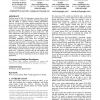Free Online Productivity Tools
i2Speak
i2Symbol
i2OCR
iTex2Img
iWeb2Print
iWeb2Shot
i2Type
iPdf2Split
iPdf2Merge
i2Bopomofo
i2Arabic
i2Style
i2Image
i2PDF
iLatex2Rtf
Sci2ools
WWW
2009
ACM
2009
ACM
Web 2.0: blind to an accessible new world
With the advent of Web 2.0 technologies, websites have evolved from static pages to dynamic, interactive Web-based applications with the ability to replicate common desktop functionality. However, for blind and visually impaired individuals who rely upon screen readers, Web 2.0 applications force them to adapt to an inaccessible use model. Many technologies, including WAIARIA, AJAX, and improved screen reader support, are rapidly evolving to improve this situation. However, simply combining them does not solve the problems of screen reader users. The main contributions of this paper are two models of interaction for screen reader users, for both traditional websites and Web 2.0 applications. Further contributions are a discussion of accessibility difficulties screen reader users encounter when interacting with Web 2.0 applications, a user workflow design model for improving Web 2.0 accessibility, and a set of design requirements for developers to ease the user's burden and increa...
Internet Technology | Screen Reader Users | Web 2.0 Accessibility | Web 2.0 Applications | WWW 2009 |
| Added | 21 Nov 2009 |
| Updated | 21 Nov 2009 |
| Type | Conference |
| Year | 2009 |
| Where | WWW |
| Authors | Joshua M. Hailpern, Loretta Guarino Reid, Richard Boardman, Srinivas Annam |
Comments (0)

